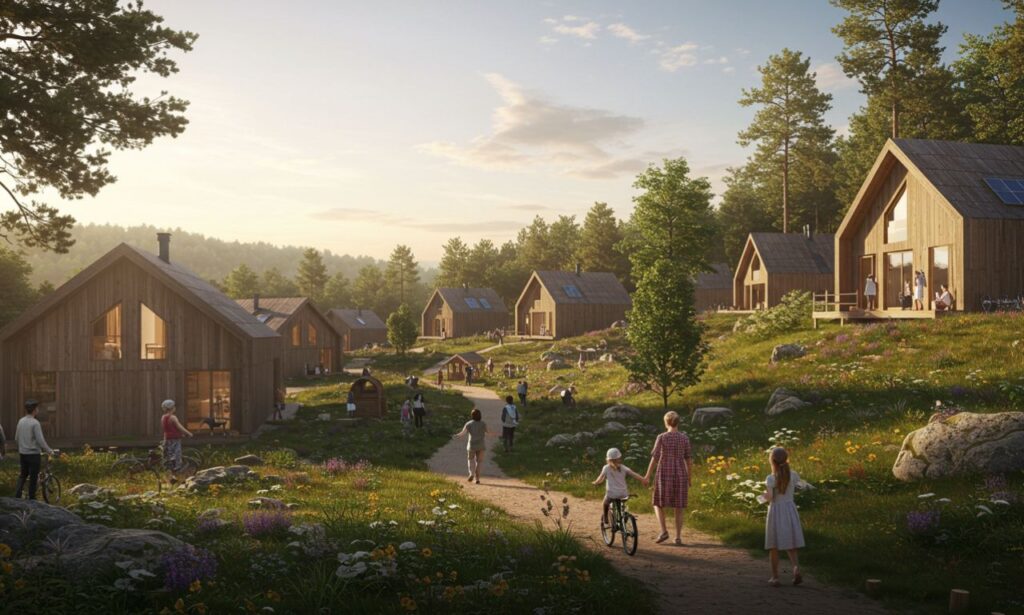The word sodziu, which finds its roots in Lithuanian language and culture, refers to a rural village or small countryside community. It evokes images of traditional life—neighbors working side by side, intergenerational homes, and shared responsibilities. However, in 2025, sodziu is no longer just a nostalgic concept. It has become a modern model of how rural life can blend heritage, innovation, and sustainability in the face of global shifts.
This article explores the meaning and origins of sodziu, its role in historical rural life, and why it’s gaining relevance again today. From digital nomads settling in quiet towns to climate-conscious communities redefining agriculture, the sodziu is being reimagined—and reclaimed—for the future.
Understanding the Meaning and Cultural Depth of Sodziu
At its core, sodziu refers to a village or rural settlement defined by its close-knit structure, land-based livelihood, and strong communal ties. Historically, these communities thrived through shared work, mutual aid, and the wisdom passed from one generation to the next. Farms, gardens, local markets, and traditional rituals were the lifeblood of the sodziu, shaping both daily life and long-term identity.
But sodziu is more than geography. In modern discussions, it also represents a way of living—community-oriented, grounded in nature, and resistant to the alienation often found in urban life. It has become a metaphor for intentional living, for choosing slow over fast, cooperation over competition, and local resilience over global dependency.
The Historical Role of the Sodziu in Rural Society
In the past, sodziu communities were deeply self-sufficient. People grew their food, repaired their own tools, and depended on their neighbors rather than centralized systems. Every task—from planting to harvesting, building to baking—was shared among families who often lived just a short walk from each other.
Cultural traditions held sodziu life together. Songs, dances, seasonal festivals, and dialects formed a rich cultural ecosystem that was passed down orally. Elders played a central role in maintaining this memory, often becoming the storytellers and moral anchors of the village.
Yet, with the arrival of industrialization and urban migration, many sodziu communities began to decline. Young people left for cities in search of jobs, modern amenities, and new lifestyles. Rural populations aged, farms closed, and traditions risked fading into history. Despite this, the sodziu remained alive in memory—and now, it’s making a comeback.
Why Sodziu Is Becoming Relevant Again in 2025
Three major shifts have sparked renewed interest in sodziu life. First, the rise of remote work has made it possible for people to live anywhere with a decent internet connection. With high-speed broadband reaching more rural areas, small towns and villages have become viable options for digital workers seeking a better work-life balance.
Second, climate change has highlighted the importance of local food production, energy resilience, and community-based adaptation. Many sodziu-style communities now host regenerative farms, permaculture gardens, and solar-powered buildings as they prepare for environmental uncertainty.
Finally, more people are looking for quality of life over convenience. They want to escape the stress, cost, and pollution of city living. In the sodziu, they find space, community, and a deeper connection to nature—without sacrificing access to technology or modern comforts.
The Economic Foundations of the Modern Sodziu
Today’s sodziu blends traditional knowledge with new economic models. While small-scale farming and craft-making remain important, many communities also host coworking spaces, eco-tourism businesses, and value-added production ventures.
Residents may grow vegetables and make cheese by day, and freelance as designers or coders by night. Others build micro-enterprises focused on handmade goods, herbal skincare, or woodwork. In some sodziu villages, cooperatives allow members to share equipment and collectively market their goods online. It’s a diverse, adaptive economy that values both place-based skills and global connectivity.
Governance, Cooperation, and the Spirit of Commons
Traditionally, sod-ziu governance relied on trust and informal norms. Disputes were settled within the community, often guided by the wisdom of elders or local customs. In modern versions, that same spirit is preserved, but through updated tools.
Rural cooperatives are now formalized legal structures that allow for collective ownership of land, solar infrastructure, and farming equipment. Some sodziu communities use open-source platforms to conduct transparent budgeting, participatory decision-making, and shared project management. These innovations ensure that governance stays democratic and localized, even as technology evolves.
Culture and Continuity
Culture is the soul of any sod-ziu. In many communities, preserving traditional songs, dances, recipes, and dialects is not just about nostalgia—it’s about resilience. As globalization blurs cultural distinctions, sodziu communities offer a counterbalance by keeping local identity alive.
In 2025, cultural preservation is aided by technology. Digital archives, podcasts, YouTube channels, and virtual museums help store and share traditional knowledge. Festivals are livestreamed for diasporas. Young people learn folk music from elders, then remix it into modern genres, bridging generations while keeping the sodziu spirit vibrant.
The Rise of the Digital Sodziu
Even for those who no longer live in rural areas, the sodziu remains relevant through digital connection. Former residents and their descendants contribute remotely—funding projects, volunteering online, or joining virtual town meetings.
Digital sodzius are also forming: small, intentional communities that gather around shared values online and then collaborate on land-based projects. Hybrid models allow people to participate in local governance, share educational resources, and engage in cultural events regardless of physical location.
Policy and Planning
For the sod-ziu to flourish, a supportive policy is crucial. Governments and NGOs can play a vital role by ensuring fast internet access, providing funding for community-led agriculture, and protecting rural landscapes from overdevelopment.
Educational support is also essential. Rural schools need updated infrastructure and curricula that combine traditional knowledge with digital skills. Programs that support youth engagement in farming, entrepreneurship, and heritage work can ensure that sodziu communities stay alive for future generations.
Challenges Ahead for Sodziu Communities
Despite its potential, the sodziu revival faces obstacles. Rural areas still struggle with aging populations, limited healthcare access, and economic inequality. Land fragmentation and climate shocks—such as droughts or wildfires—can threaten sustainability. Moreover, there is a risk that tourism and outside investment will erode authenticity if not handled thoughtfully.
For sodziu to thrive, communities must balance openness with protection, modernization with tradition, and growth with integrity.
A Vision for the Future of Sodziu
Imagine a sodziu where every home is energy self-sufficient, where local food systems feed the village and surrounding towns, and where elders mentor youth in both heritage crafts and startup thinking. Imagine data dashboards tracking soil health, water use, and biodiversity, visible to every resident. Imagine a calendar of events that blends ancestral rituals with modern innovation fairs.
This is not fantasy. These kinds of sod-ziu communities are emerging across the world—from Eastern Europe to Latin America, from Africa to rural North America. They are living laboratories of resilience, offering a grounded, human-scaled response to global challenges.
Conclusion
Sodziu is not just a village. It’s an idea of cooperation, sustainability, culture, and home. In a time marked by rapid change, ecological disruption, and digital overload, the sodziu offers an alternative vision: one that values connection over consumption, belonging over branding, and place over placelessness.
As more people seek purpose and community, sodziu may well become the blueprint for how to live meaningfully in the 21st century. It is not about going backward, but about bringing forward what was wise, durable, and human from the past—and adapting it for a better future.







